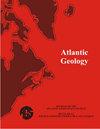Sonar and LiDAR investigation of lineaments offshore between central New England and the New England seamounts, USA
IF 0.9
4区 地球科学
Q2 GEOLOGY
引用次数: 2
Abstract
High-resolution multibeam echosounder (MBES) and light detection and ranging (LiDAR) data, combined with regional gravity and aeromagnetic anomaly maps of the western Gulf of Maine, reveal numerous lineaments between central New England and the New England seamounts. Most of these lineaments crosscut the NE-SWtrending accreted terranes, suggesting that they may be surface expressions of deep basement-rooted faults that have fractured upward through the overlying accreted terranes or may have formed by the upward push of magmas produced by the New England hotspot. The 1755 Cape Ann earthquake may have occurred on a fault associated with one of these lineaments. The MBES data also reveal a NW-SE-oriented scarp just offshore from Biddeford Pool, Maine (Biddeford Pool scarp), a 60-km-long, 20-km-wide Isles of Shoals lineament zone just offshore from southeastern New Hampshire, a 50-m-long zone of mostly low-lying, WNW-ESE-trending, submerged ridge-like features and scarps east of Boston, Massachusetts, and a ~180-km-long, WNW-ESE-trending Olympus lineament zone that traverses the continental margin south of Georges Bank. Three submarine canyons are sinistrally offset ~1–1.2 km along the Thresher canyon lineament of the Olympus lineament zone.美国新英格兰中部和新英格兰海山之间近海地貌的声纳和激光雷达研究
高分辨率多波束回声测深仪(MBES)和光探测与测距(LiDAR)数据,再加上缅因湾西部的区域重力和航磁异常图,揭示了新英格兰中部和新英格兰海山之间的众多线性构造。这些线性构造大多横切NE-SW走向的增生地体,表明它们可能是深层基底根断层的表面表现,这些断层通过上覆的增生地层向上断裂,或者可能是由新英格兰热点产生的岩浆向上推动形成的。1755年的安角地震可能发生在与其中一条线理相关的断层上。MBES数据还显示,缅因州Biddeford Pool近海有一个西北-东南走向的陡崖(Biddeford Pool陡崖),新罕布什尔州东南部近海有一条60公里长、20公里宽的浅滩群岛线性构造带,马萨诸塞州波士顿以东有一条50米长的带,大部分为低洼、WNW-ESE走向、淹没的山脊状特征和陡崖,长约180公里,横贯乔治银行以南大陆边缘的WNW-ESE走向奥林巴斯线性构造带。三个海底峡谷沿着奥林巴斯线理带的Thresher峡谷线理向左偏移约1–1.2公里。
本文章由计算机程序翻译,如有差异,请以英文原文为准。
求助全文
约1分钟内获得全文
求助全文
来源期刊

Atlantic Geology
GEOLOGY-
CiteScore
2.10
自引率
18.80%
发文量
0
审稿时长
>12 weeks
期刊介绍:
Atlantic Geology (originally Maritime Sediments, subsequently Maritime Sediments and Atlantic Geology) covers all aspects of the geology of the North Atlantic region. It publishes papers, notes, and discussions on original research and review papers, where appropriate to the regional geology.
 求助内容:
求助内容: 应助结果提醒方式:
应助结果提醒方式:


